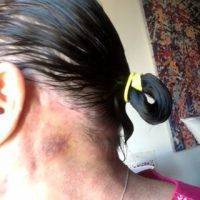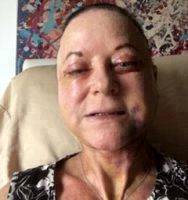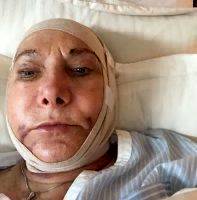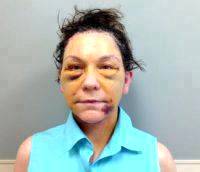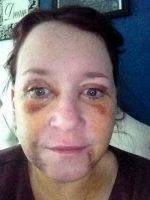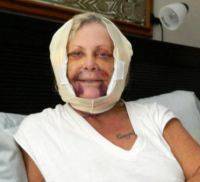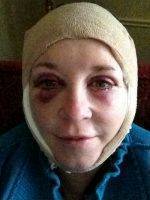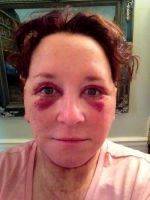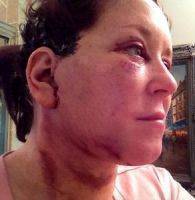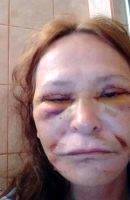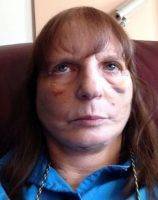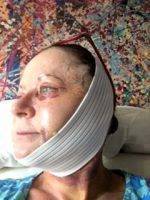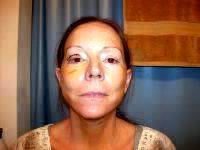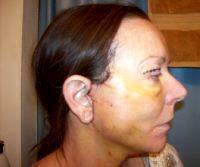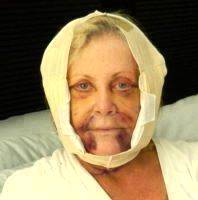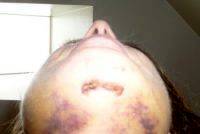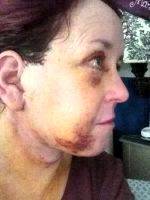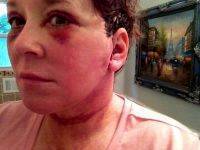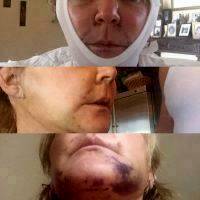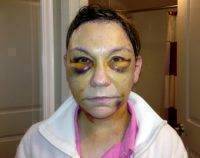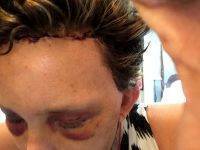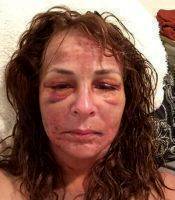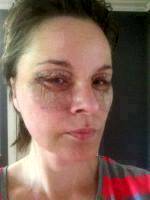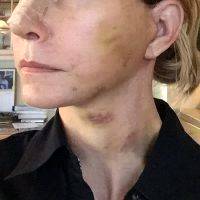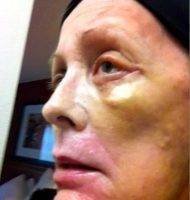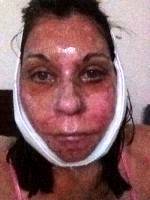Facelift Bruising Pictures
Look at the pictures of bruising after facelift here. Bruising can last up to 2 weeks after a facelift in the best of circumstances. A hematoma or collection of blood is a relatively rare complication that can occur in 5% or fewer of cases.
Symptoms and signs of hematoma include significantly worse pain, swelling or bruising on one side of the face compared to the other. As long as it is identified and treated appropriately, the long term result will not be affected by this however.
This could prolong the recovery causing prolonged bruising and swelling. Some doctors recommend various supplements such as Arnica to help eliminate bruising. Patients should ask their surgeon first before starting on any supplements. Specific concerns after surgery should be directed to your surgeon.
Bruising is normal following facelift
Bruising is to be expected following facelift procedures. The degree of bruising and swelling can certainly vary from one patient to another. Having hematoma as a complication will significantly increase the bruising and swelling and can delay the time it takes to resolve.
In an uncomplicated procedure, it typically takes around two weeks for the visible swelling and bruising to resolve to the point that it can’t be seen by others. However, if someone has a hematoma, or severe bruising, it can take several weeks for the bruising to fade.
No need to be alarmed at this point. Be patient with the healing process and you will be amazed how your body gradually heals and repairs itself following surgery.
The presence of blood and the time of that blood is the tissues might be the reason for the permanency of swelling even after three weeks. Most bruising improves by the 3 week mark, but with a hematoma this can be prolonged to even the 6 or 8 week mark
Bruising can depend on medication or even diet, do discuss all of this with your surgeon who will fully medically assess your suitability for the procedure.
After a hematoma, bruising can still be present at this point. If there is swelling and it feels tense, its best to obtain regular follow up of your progress by your doctor. You want to make sure your condition resolves uneventfully.
Bruising within the tissue should settle within the next 3 to 4 weeks but, if it is very extensive, it can take much longer than this, sometimes several months
Rapid Healing After Facelifts
There are many things that can be done to minimize bruising after a facelift. There are also materials that a surgeon can use to decrease bruising as well.
Patients typically reduce bruising after surgical procedures by doing a few simple things:
- Maintaining low activity levels and avoiding straining for the first week
- Sleeping with their head elevated above their heart
- Wearing the compression garment after the surgery
- Icing religiously for the first 72 hours (usually 30 minutes every hour while awake)
- Taking herbal preparations (Arnica capsules and cream, Bromelain extract)
- Avoiding many substances for 2 weeks before surgery (aspirin, motrin, advil, garlic extracts/pills/meals, vitamins A and E, herbal supplements, etc.)
The surgeon can use certain accessory materials, such as Fibrin glue or platelet enriched plasma, to help with early clotting and healing. There is also a role for certain surgical techniques in reducing brusing. The anesthesiologist and their ability to maintain the blood pressure in a stable way is very important as well.
With all that being said, bruising to a certain extent is unavoidable after facelift surgery. Men do tend to have more bruising due to the presence of hair follicles and thicker skin in general. Hematomas will occur in even the most experienced hands.
Below you will find photos of real patients after facelift. During recovery after facelift, side effects such as bruising and hematoma can occur. Look at the pictures to see this. The photographs show the patients during recovery from the first day after surgery.
Bruising After Facelift Gallery:
- Bruising From Facelift (1)
- Bruising From Facelift (1)
- Bruising From Facelift (2)
- Bruising From Facelift (3)
- Facelift Bruising Pictures (1)
- Facelift Bruising Pictures (2)
- Facelift Bruising Pictures (3)
- Facelift Bruising Pictures (4)
- Facelift Bruising Pictures (5)
- Facelift Hematoma Images (1)
- Facelift Hematoma Images (2)
- Facelift Hematoma Images (3)
- Facelift Hematoma Images (4)
- Facelift Hematoma On Chin And Neck (1)
- Facelift Hematoma On Chin And Neck (2)
- Facelift Hematoma On Chin And Neck (3)
- Facelift Hematoma Photos (1)
- Facelift Hematoma Photos (2)
- Facelift Hematoma Photos (3)
- Facelift Hematoma Photos (4)
- Facelift Hematoma Photos (5)
- Facelift Hematoma Photos (6)
- Facelift Hematoma Photos (7)
- Facelift Hematoma Treatment
- Facelift Hematoma Under Eyes (1)
- Facelift Hematoma Under Eyes (2)
- Facelift Hematoma Under Eyes (3)
- Facelift Hematoma Under Eyes (4)
- Facelift Hematoma
- Female Facelift Hematoma (1)
- Female Facelift Hematoma (2)
- Female Facelift Hematoma (3)
- Female Facelift Hematoma (4)
- Hematoma After Rhytidectomy (1)
- Hematoma After Rhytidectomy (2)
- Hematoma After Rhytidectomy (3)
- Hematoma After Rhytidectomy (4)
- Hematoma After Rhytidectomy (5)
- Hematoma After Rhytidectomy Pictures (1)
- Hematoma After Rhytidectomy Pictures (2)
- Hematoma After Rhytidectomy Pictures (3)
- Hematoma After Rhytidectomy Pictures (4)
- Hematoma After Rhytidectomy Pictures (5)
- Hematoma Following Facelift Surgery
- Hematoma From Face Lift Operation
- Hematoma In Rhytidectomy
- Hematoma With Facelift
- Minor Hematoma Facelift Pictures
- Photo Of Hematoma After Facelift Surgery
- Photos Of Post Facelift Hematoma (1)
- Photos Of Post Facelift Hematoma (2)
- Photos Of Post Facelift Hematoma (3)
- Photos Of Post Facelift Hematoma (4)
- Pictures Of Hematoma Facelift Surgery (1)
- Pictures Of Hematoma Facelift Surgery (2)
- Post Facelift Bruising Pictures (1)
- Post Facelift Bruising Pictures (2)
- Post Facelift Bruising Pictures (3)
- Post Facelift Bruising Pictures (4)
- Post Facelift Bruising Pictures (5)
- Post Facelift Bruising Pictures (6)
- Post Facelift Bruising Pictures (7)
- What Does A Facelift Hematoma Look Like Photo





